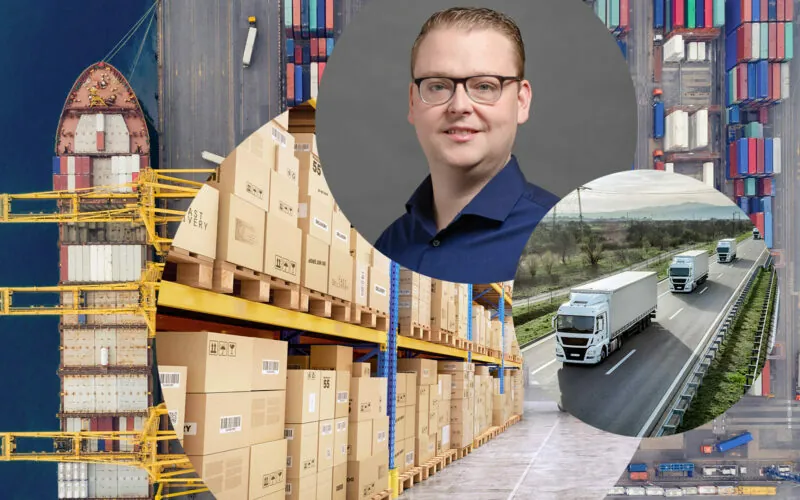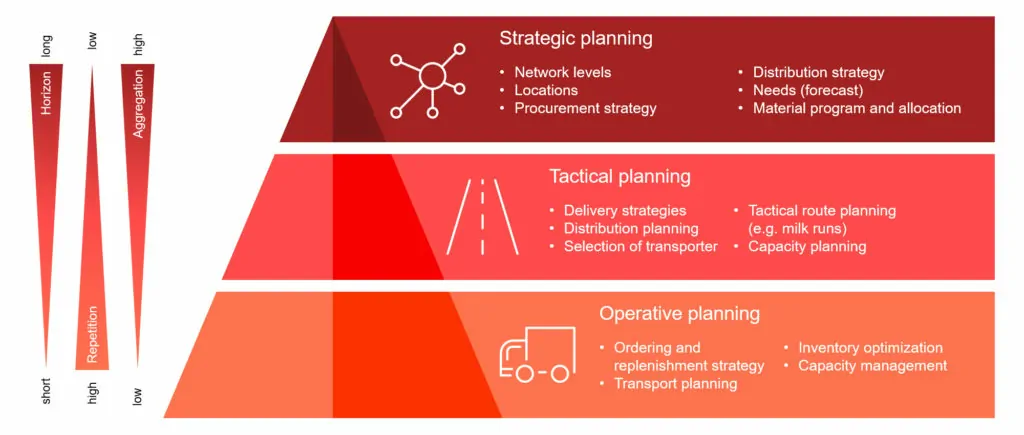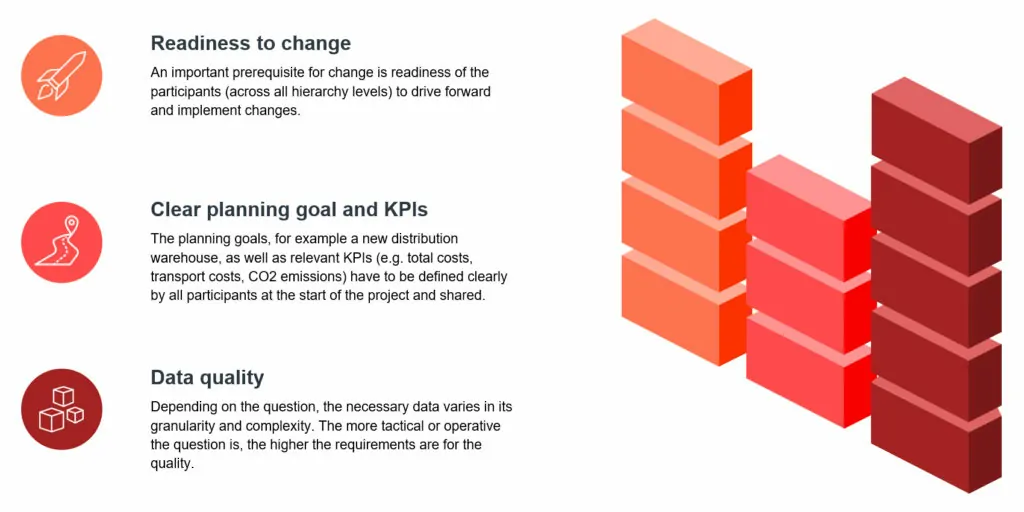Highlight

Successful together – our valantic Team.
Meet the people who bring passion and accountability to driving success at valantic.
Get to know usDecember 18, 2020

Markus Hoff has been Senior Consultant at valantic in the logistics management sector since March 2015 and has focused since the beginning on the topics of strategic network planning and scenario-based simulation of supply chains. In the interview, he provides insight into the topic of supply chain design, where what’s important is making decisions that concern location questions for production and the orientation of logistics.
Hello, Markus, can you explain the topic supply chain design for us in a little more detail?
Honestly, supply chain design isn’t so easy to explain since it forms the basis for a company’s effective and successful supply chain management and is defined differently depending on the partner in question. From my point of view, you can simplify things and say that in supply chain design, a company’s entire logistics network is planned in detail and checked with the help of a simulation. Here, initially important strategic decisions are made end-to-end, for example supplier selection, location planning for warehouses and plants, and the supply of customers.
In our team, we organize supply chain design into strategic, tactical, and operative levels and orient ourselves according to the supply chain planning matrix in order to assign the different planning horizons and tasks. (see figure).

In the strategic planning, the basic structure of a supply chain is defined, with suppliers, production locations, warehouses, and customer structures. Within the tactical and operative planning, this basic structure is enriched with additional information, such as delivery strategies or transit carrier selection, so that a complete supply chain results. Of course, within a project, I don’t necessarily have to concern myself with all levels and with the planning information; depending on the question, it’s possible to focus on just the relevant topics.
Decisions relating to supply chain design should be oriented according to the company’s sales and product strategies. Accordingly, the interfaces at the company are also many and varied, from purchasing to production and distribution on through to sales, and closely interlocked with one another, which makes the whole topic very interesting.
Which questions can be answered with supply chain design and what advantages can I enjoy thanks to simulation and optimization?
The big advantage of simulation or optimization is that I can check planned or unplanned changes to my logistics network with defined KPIs and evaluate their effects without having to change my supply chain in reality. This makes it possible to optimize my various target functions, such as minimal transport costs or maximum service level. In reality, these target functions are usually contrary to one another and they have to be brought into balance in order to get an optimal configuration of my network.
Due to the simulation and optimization possibilities, the questions in supply chain design are many and varied, which is why I would like to list just a few:
The respective topics vary between strategic and tactical questions and, depending on their characteristics, require different levels of detail. With the simulation or optimization it is possible to reduce transport costs, minimize inventories, and design the supply chain so that it is sustainable.
In the current crisis situation we have determined how important a supply chain that works well is for supply. How can companies better adjust to possible crises or even protect themselves?
That’s a very interesting question, which of course people are talking about a lot right now. As a company, I can prepare myself for possible changes and disturbances within the supply chain without further ado. Appropriate situations can be examined in more detail within the simulation using so-called what-if analyses and risk analyses.
In the what-if analysis, disruptive events such as the bankruptcy of a supplier, economic and political crises, or even damage to my logistical or productive infrastructure (e.g. due to natural catastrophes) are examined. In the risk analysis, by contrast, operational events such as demand fluctuations, transport delays, and incorrect inventories are analyzed.
Appropriate events can be parameterized within the simulation down to individual areas and assigned possible variables (e.g. likelihood of occurrence and duration). Based on the simulation result, I can identify relevant weak points and define measures whose effectiveness can be checked in a new simulation in order to determine an optimal network for me. For we have to be aware of one thing: The question isn’t whether the next event will occur, but rather when it will occur and how I can prepare my company ideally for it.
What challenges do you and your team confront in a supply chain design project and how do you overcome these?
Essentially, there can always be challenges in the course of a project. This is also the nature of a simulation or optimization project since the models and results are not palpable for the participants. Important, however, is that the project starts with the right set-up. This begins with the formulation of a concrete planning goal such as the planning of a new distribution center in Europe with existing restrictions. In addition, we define relevant KPIs with which the scenario in question can be evaluated. All project participants have to “own” precisely this set-up; we advance it in the early project phase in the course of workshops across all hierarchy levels in order to achieve the necessary acceptance. In the process, we see quickly whether there is a readiness for change across all levels or whether we will have to communicate more intensively with some people in order to convince them of the project goal. In the end, the project is evaluated precisely with the simulation or optimization and the considerations are not implemented directly in the operative supply chain.

Another and frequently the biggest challenge is getting the necessary data in the appropriate detail depth and quality. Frequently at the beginning of projects, I have heard that the topic of “data” is no problem at all and that it is possible to pull all information together quickly. At that moment, I always prick up my ears and I know then that this will be a challenge. In strategic planning projects, the data is often not needed in the deepest degree of detail; most of the time it can be aggregated, such as the customer requirements across the planning period. If, however, relevant data is missing, we have always been able to work with the participants to find an appropriate solution.
What, from your point of view, are valantic’s success factors in a supply chain design project?
Personally, I believe that in addition to the necessary professional and logistical expertise, the human factor plays an important role within the project. That’s why it’s always especially important to us to understand our customer’s needs, worries, and expectations and to work together to implement the project on a level playing field. That’s why the project set-up I mentioned before is so essential at the project start. Only this way can we establish trust between our customers and us as advising team, develop a common way of thinking, and cement the partnership. In addition, our goal-oriented, analytical procedure is an important success factor. Even during the definition of individual characteristics and scenarios, we can decide together with our customers whether the selected variants will have a positive influence on the supply chains or whether we’d be better to select a different option. In the end, the goal is to find the best possible configuration of supply chains for our customers, to analyze and evaluate these, and to present fewer optimal solutions at an earlier point in the project.
Thank you very much for taking the time to speak to us; we wish you great success with your project work!
Don't miss a thing.
Subscribe to our latest blog articles.